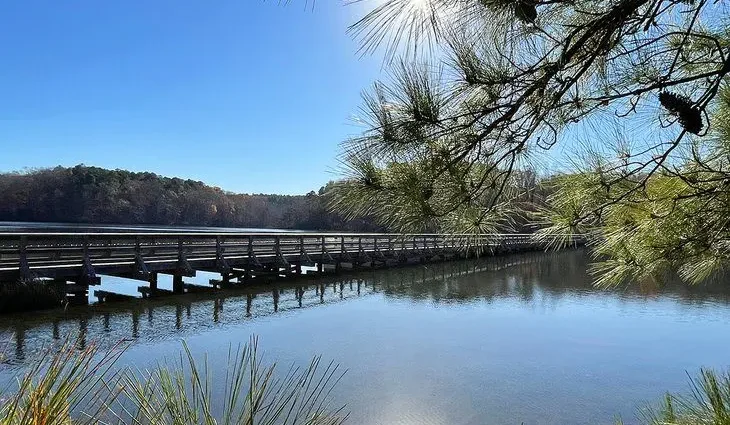Contents
- 1. Rock Island State Park
- 2. Cumberland Mountain State Park
- 3. Fall Creek Falls State Park
- 4. Burgess Falls State Park
- 5. Cummins Falls State Park
- 6. Old Stone Fort State Archaeological Park
- 7. Warriors’ Path State Park
- 8. Panther Creek State Park
- 9. Radnor Lake State Park
- 10. Dunbar Cave State Park
- 11. Pickett CCC Memorial State Park
- 12. Reelfoot Lake State Park
- 13. Chickasaw State Park
- 14. Cedars of Lebanon State Park
- 15. David Crockett Birthplace State Park
Check any map of state parks in Tennessee, and you’ll notice that you don’t have to venture far to discover an abundance of parkland from west to east and north to south. Expect to enjoy traditional activities such as hiking, nature appreciation, and camping at most parks. In fact, campsites await you at 39 of 56 state parks.
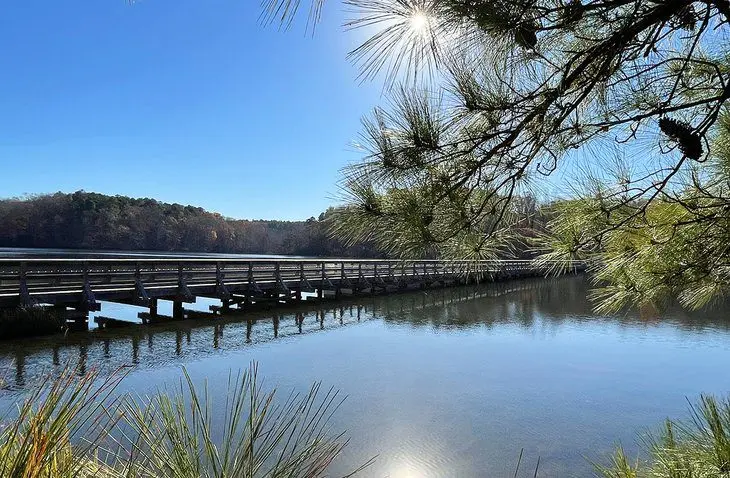
If you are heading to the state capital, you’ll be pleased that Nashville is a convenient jumping-off point for visiting and camping in three state parks: Radnor Lake, Cedars of Lebanon, and Rock Island.
Because many Tennessee state parks have water features such as lakes or reservoirs, rivers, and waterfalls, options for recreational activities expand to include boating, fishing, swimming, and having fun on the water.
At least nine state parks feature golf courses—check them out at four parks on our list (Fall Creek Falls, Warriors’ Path, Cumberland Mountain, and Chickasaw). Take to many of the park trails on your mountain bike, and enjoy three of our best picks on horseback: Panther Creek, Chickasaw, and Cedars of Lebanon.
Whatever your pleasure, satisfy your craving for outdoor fun and adventure with our list of the best state parks in Tennessee.
1. Rock Island State Park
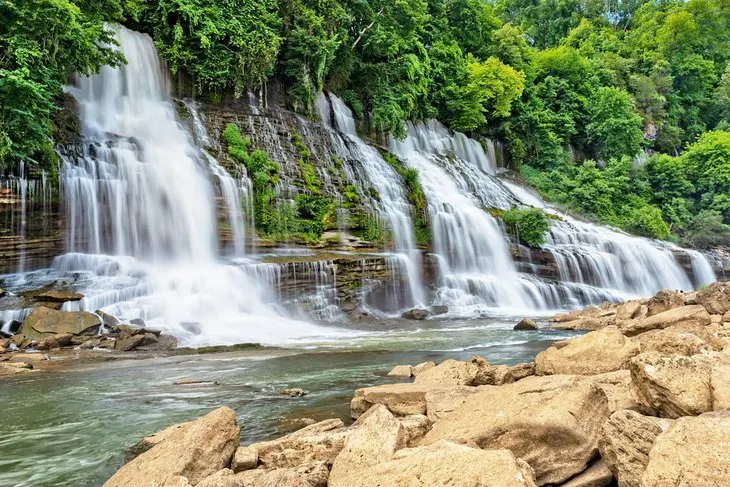
Rock Island is a popular state park located at the headwaters of Center Hill Lake, 14 miles northeast of McMinnville in central Tennessee. Caney Fork Gorge below Great Falls Dam has breathtaking scenic overlooks. Points of interest include 30-foot Great Falls, Twin Falls, and the Blue Hole. Below the falls is a textile mill from the 19th century that was once powered by the waterfall.
Observe the rugged natural features of this 883-acre park carefully and from a distance. Slippery limestone, fast-moving currents, and fluctuating water levels are the main reasons to exercise caution during your visit to the park. Some areas are off-limits for swimming, and visitors are encouraged to heed the warnings. Swimmers are directed to the natural sandy beach with boat access.
World-class kayakers thrill to the park’s white water challenges. If you wish to stay overnight, there are 10 cabins and 60 campsites, 20 of which are available year-round.
Address: 82 Beach Road, Rock Island, Tennessee
2. Cumberland Mountain State Park
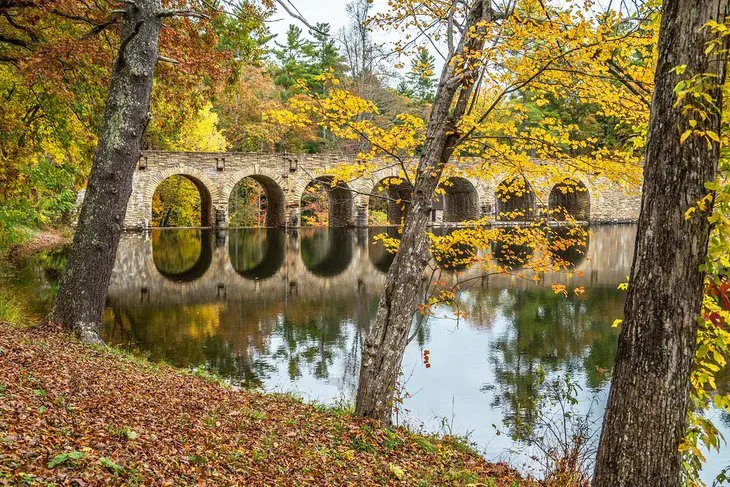
Cumberland Mountain State Park is popular because there are so many things to do in this scenic 1,720-acre park. It’s located at roughly 2,000-foot elevation in the Cumberland Plateau. Start with an easy walk on the mile-long loop trail around Byrd Lake. The park has 14 miles of hiking trails and four miles of mountain biking trails. Enjoy Byrd Lake in your own boat or one that you rent from the park—kayaks, pedal boats, paddleboards, and rowboats are available. Fish for largemouth bass, catfish, crappie, and rainbow trout.
Among the park’s amenities are a wading pool for the kids and an Olympic-sized pool where you can swim laps or dive off two one-meter diving boards. One of the most photographed features is the seven-arch sandstone bridge across Byrd Lake. This structure is among the largest ever built by the Civilian Conservation Corps in the 1930s.
Throughout the year, special events are hosted at the park such as rock-climbing workshops and kite-flying days. There are no dull moments.
Address: 24 Office Drive, Crossville, Tennessee
3. Fall Creek Falls State Park

Fall Creek Falls State Park is located in the scenic Cumberland Plateau of Eastern Tennessee and is the place to visit if you’re a nature lover. The 30,000-acre park has everything for visitors seeking natural beauty.
First, consider Fall Creek Falls, the 256-foot waterfall for which the park is named. In addition to this showpiece, there’s Piney Falls, Cane Creek Falls, Cane Creek Cascades, and a nature center to promote education. In a mostly wilderness setting, another asset is a 345-acre lake, where anglers have made state record-setting catches.
Hike and bike the trails (there are more than 56 miles for walking and 24 miles to explore on two wheels); go boating; and fish for catfish, bluegill, and largemouth bass in Fall Creek Lake. Golf at a course rated by Golf Digest as one of the best in America. Try out the canopy challenge aerial course if you’re feeling adventurous. It offers more than 70 obstacles to tackle.

Accommodation options include 222 campsites, group camping, two group lodges, and 20 cabins directly on the lake. Make yourself at home in a spectacular setting.
Address: 2009 Village Camp Road, Spencer, Tennessee
4. Burgess Falls State Park
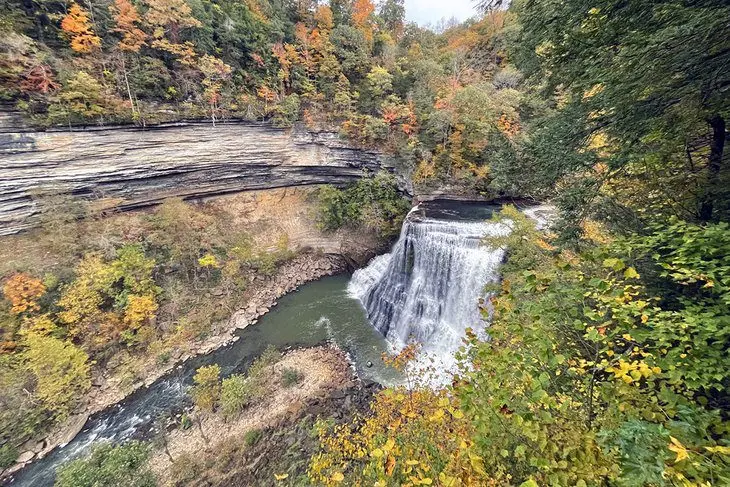
On Falling Water River, Burgess Falls State Park is all about waterfalls—not just one but four cascades that cover more than 250 feet of elevation. Because the falls are the main attraction at this 275-acre day park, take your time on the 1.6-mile loop trail that is rated strenuous.
You might find it fairly easy if you don’t mind lots of stairs. You’ll see smaller cascades first, building to the largest one that plunges 130 feet into a gorge.
Burgess Falls State Park was once occupied by Indigenous communities of the Cherokee and Chickasaw, who used it as a hunting ground. A late 19th-century gristmill and sawmill are historic features of the park, which is located in the central part of Tennessee south of Cookeville.
Address: 4000 Burgess Falls Drive, Sparta, Tennessee
5. Cummins Falls State Park
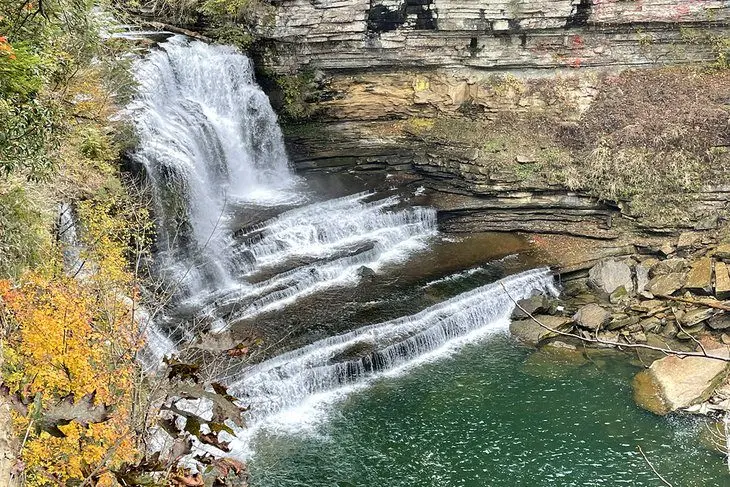
Cummins Falls, the eighth largest waterfall in Tennessee, is the star attraction of this 306-acre day-use park, named state park of 2021 by the Tennessee Department of Environment and Conservation. Cummins Falls State Park is situated nine miles north of Cookeville.
You’ll need a permit to access the gorge and base of the falls, located on Blackburn Fork State Scenic River. Plan on spending two to three hours to hike the three-mile loop trail. Take photos, enjoy a refreshing dip in ye olde swimming hole, and admire the majesty of the 75-foot falls. The cascade is in two drops, with the first one plunging 50 feet into a pool.
Take care while navigating the trail and hiking through the gorge. It’s rated strenuous due to slippery surfaces, multiple stream crossings, and deep pools. Take your time and soak up the surroundings. Access to outstanding natural attractions like Cummins Falls is not without risk and challenge, but it’s worth the effort.
Address: 390 Cummins Falls Lane, Cookeville, Tennessee
6. Old Stone Fort State Archaeological Park
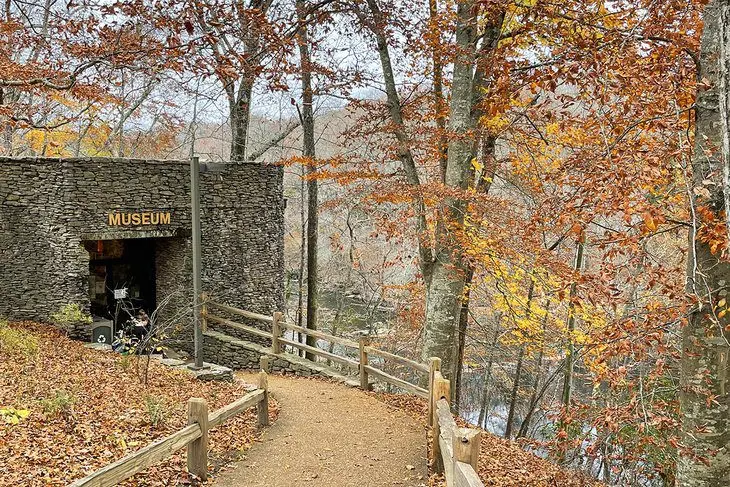
Old Stone Fort State Archaeological Park is one of seven archaeological parks and areas in Tennessee. It’s a world away in spirit and history, although only one mile of distance separates the 51-site campground from the public pool in nearby Manchester.
The site is a place of antiquity, dating back 2,000 years, and to this day, it retains mystery as to its original purpose. It was misidentified as a fort by early settlers. Today’s visitors see a 50-acre hilltop enclosure of mounds and walls built into limestone cliffs. One theory is that Indigenous people used this space as a ceremonial gathering area for hundreds of years.
From behind the stone museum, orient yourself by accessing the easy-to-moderate 1.4-mile loop trail with interpretive signage. View three tiers of picturesque falls from the trail, and the foundation of an old paper mill. Several other walks branch off the main interpretative trail, which informs you about the development of sawmills, gristmills, and even a Civil War gunpowder mill during the 1800s. Park visitors stroll the trails, camp, paddle, and fish on the Duck River.
Address: 732 Stone Fort Drive, Manchester, Tennessee
7. Warriors’ Path State Park

Take your cue from the park and trail names to affirm that Warriors’ Path State Park is a launching pad for outdoor adventure. Hike the 2.5-mile Devil’s Backbone Trail to access scenic Devil’s Backbone State Natural Area.
Apart from hiking and mountain biking, go horseback riding, fishing, and boating (rent from the marina if you don’t have a boat). The campground has 94 sites, complete with grills, tables, and water and electric hookups.
Visitors to Warriors’ Path can also play at the 18-hole golf course. The 950-acre park is on the Patrick Henry Reservoir along the Holston River. The closest community of Kingsport is located just south of the Kentucky state line in the northeast corner of Tennessee.
Address: 490 Hemlock Road, Kingsport, Tennessee
8. Panther Creek State Park

Start your visit to Panther Creek State Park by getting an eagle’s-eye view of the surrounding Appalachian Mountains. Point Lookout Trail, a 1.9-mile loop, offers the best way to get a panoramic view of Cherokee Lake and the Cumberland Mountains.
This trail is just one of 17 hiking trails that cover more than 30 miles of terrain. Mountain bikers can take in the views on 15 miles of trails. The flat Old Wagon Trail is a great option for young tourists on bikes, while the two-mile Trout Lily Trail loop can satisfy experienced cyclists.
Bring your own boat to explore the reservoir. Rentals aren’t available in the park, but there is a boat ramp, available from mid-April to late September, to launch your fishing or paddling adventure. During the winter, expect to see over-wintering osprey and eagles and, at other times of the year, watch for songbirds.
Seven miles of riding trails, such as Hunt Knob Trail, await visitors who are exploring the Holston River valley on horseback. Modern camping facilities with 50 sites accommodate every rig and style of tent. Young children will light up at the sight of the playground. There’s something for everyone.
Address: 2010 Panther Creek Road, Morristown, Tennessee
9. Radnor Lake State Park
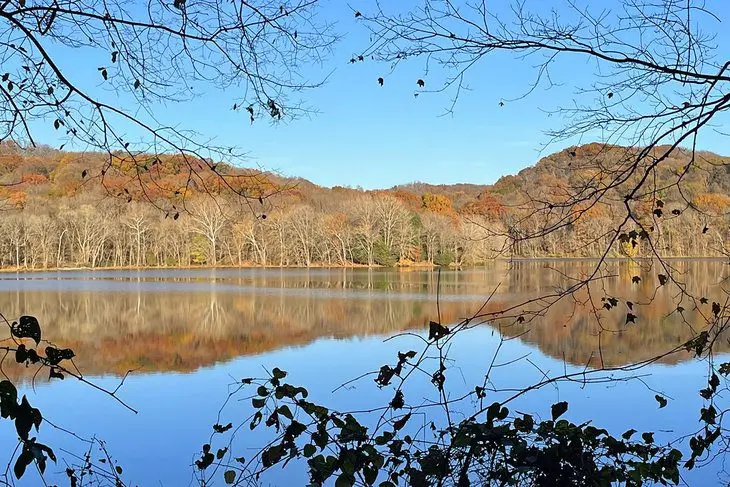
Some people think of Radnor Lake State Park as the Walden Pond of Nashville. That’s because this 1,368-acre day-use park is a protected nature preserve, ecologically diverse in plants, animals, and birds. Despite its proximity to Nashville, you have a good chance of being rewarded for bringing your binoculars and camera.
Birds and wildlife are not bothered here by dogs, bikes, and swimming activities because they are not allowed outside of the Otter Creek Road Trail.
The park is popular, so avoid prime time. The beginning and end of the day are the best times to visit the park, eight miles south of Nashville. When the season permits, you can indulge in a luxurious canoe float on the 85-acre lake.
Around 7.5 miles of hiking trails are rated easy to strenuous. When you’re done with the easy 1.3-mile loop around Radnor Lake, check out the gift shop and educational programs that are offered throughout the year.
Address: 1160 Otter Creek Road, Oak Hill, Tennessee
10. Dunbar Cave State Park
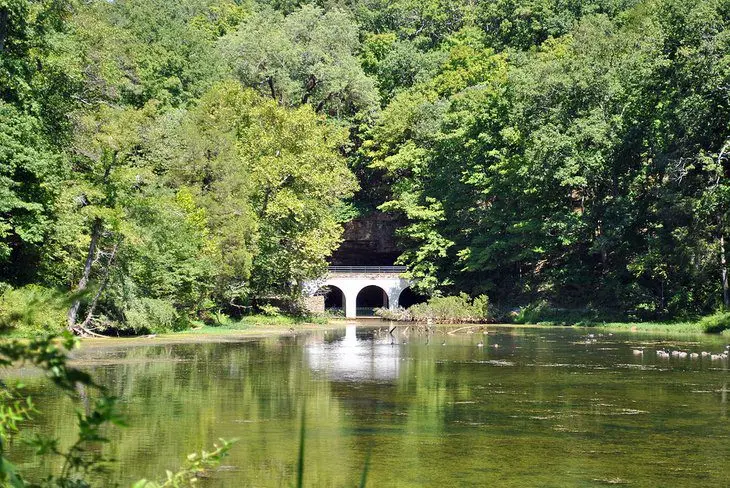
Dunbar Cave State Park, a 144-acre property in Clarksville, has been around for millennia and has had many lives. It was a sacred place to Indigenous people, who decorated the cave walls with pictographs and used the site for ceremonial purposes in the 14th century. That art is still visible today.
In a move that would be considered unthinkable today, a country singer bought the property in 1948, then built a golf course and resort where big bands helped tourists dance the night away.
The park was acquired by the state in 1973 and is appreciated for geological features such as rock formations, sinkholes, and caves. The ancient art in the cave has been preserved, and visitors who wish to explore the cave and see pictographs must sign up for a seasonal guided tour.
Visitors can walk their dogs on the 1.9-mile Dunbar Cave Recovery Trail. This moderately forested trail skirts 20-acre Swan Lake, which attracts wildlife and birds—including swans.
Address: 401 Old Dunbar Cave Road, Clarksville, Tennessee
11. Pickett CCC Memorial State Park
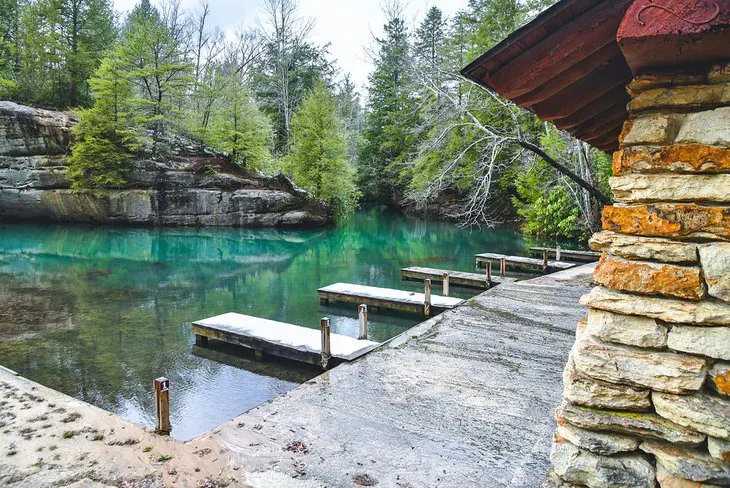
The nearly 21,000-acre Pickett CCC Memorial State Park pays tribute to the efforts of CCC workers from the Civilian Conservation Corps, who completed many projects during the wartime years of the 1930s and early 1940s. Among the legacy they left at Pickett are hiking trails, a recreation lodge, five cabins, and a 12-acre lake stocked with trout in the summer.
This park is special because it was the first in the Southeast to receive a “dark sky park” designation. It offers special star events throughout the year in its astronomy field. With only 26 campsites, 16 of which have electric service, there is minimal intrusion by humans. Bears make their home here and, if you’re lucky, you’ll see one from a distance.
Enjoy the peace at Pickett, located next to 120,000-acre Big South Fork National River, on the border of Tennessee and Kentucky.
Address: 4605 Pickett Park Hwy, Jamestown, Tennessee
12. Reelfoot Lake State Park

Although its location in the northwest corner of Tennessee seems remote, Reelfoot Lake State Park is only a two-hour drive from Memphis. Whether you’re resting up for a city visit or recovering from one, try to include Reelfoot on your itinerary. It’s the only natural lake in Tennessee.
This vast 15,000-acre body of water is also located only three miles from the Mississippi River—that means flyway if you’re a migrating bird, and bird-watching if you’re a tourist. Reelfoot is the place to see hundreds of white pelicans migrating in the fall. Eagles (bald and golden) are so abundant, they are honored by a festival every February.
Go to Reelfoot to view birds (270 species) and admire the towering bald cypress trees where they perch above the shallow water. Meander easy hiking trails. Rent a kayak or canoe and bliss out during a quiet paddle. Fifty species of fish may tempt anglers to cast a line.
To stay for more than a day trip, reserve a deluxe cabin or a site in the campground. Bring your questions to the visitor center and your curiosity to the heritage center and museum.
Address: 2595 Highway 21E, Tiptonville, Tennessee
13. Chickasaw State Park
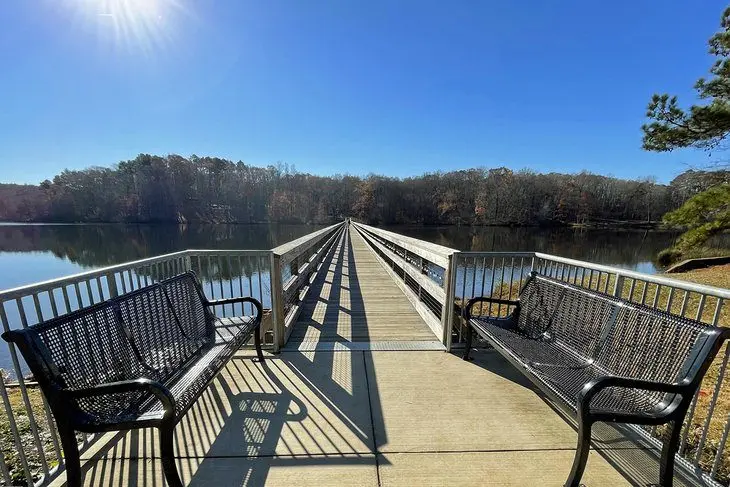
Chickasaw State Park occupies higher ground in terms of elevation, as well as being of cultural significance to members of the Chickasaw Nation who once occupied this part of West Tennessee. Begin your explorations with an easy stroll on the 640-foot pedestrian bridge across Lake Placid. Rent a rowboat or pedal boat and enjoy sightings of birds and wildlife.
Hiking trails range from easy to strenuous with the most popular nature trail taking you on an easy 1.75-mile walk around the lake.
Another way to explore the park is on horseback. Bring your own horse or rent one by the day or hour. Equestrian campers stay in a specially designated campground with stalls for horses. Other accommodations include an RV campground, a tent campground with water views, a group lodge, and lakeside cabins. Chickasaw also has an 18-hole golf course.
Address: 20 Cabin Lane, Henderson, Tennessee
14. Cedars of Lebanon State Park
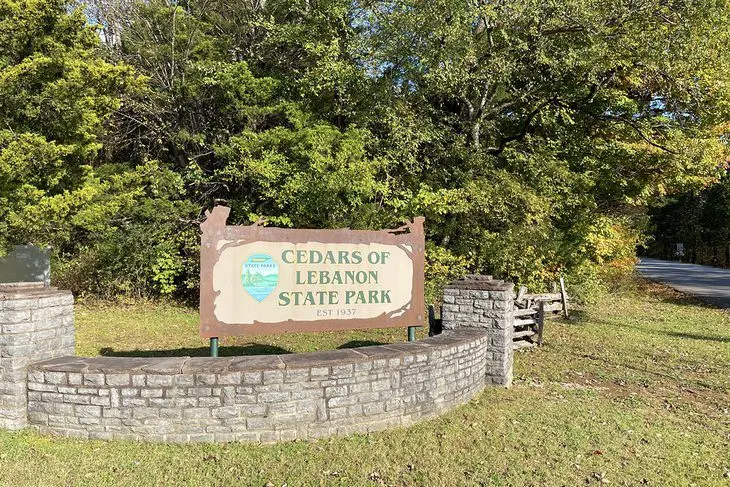
Cedars of Lebanon State Park is a popular choice for visitors who want a camping base close to Nashville in a state park with all the amenities and plenty of things to do. The drive between the park and city is 32.5 miles.
There are three campgrounds, comprising a total of 117 campsites, with restrooms, showers, and paved camping pads. Other accommodation options include a group lodge and nine cabins.
Hiking at Cedars of Lebanon is a treat because you never know what you’ll discover. You’ll be fascinated by tree burls, drop-offs, sinkholes, and caves. One of the best hikes is 4.2-mile Hidden Springs Trail that leads to a couple of deep sinkholes. Marvel at limestone glades and admire rare wildflowers in season.
If you’re into riding, there are 12.5 miles of trails to explore on horseback.
Address: 328 Cedar Forest Road, Lebanon, Tennessee
15. David Crockett Birthplace State Park
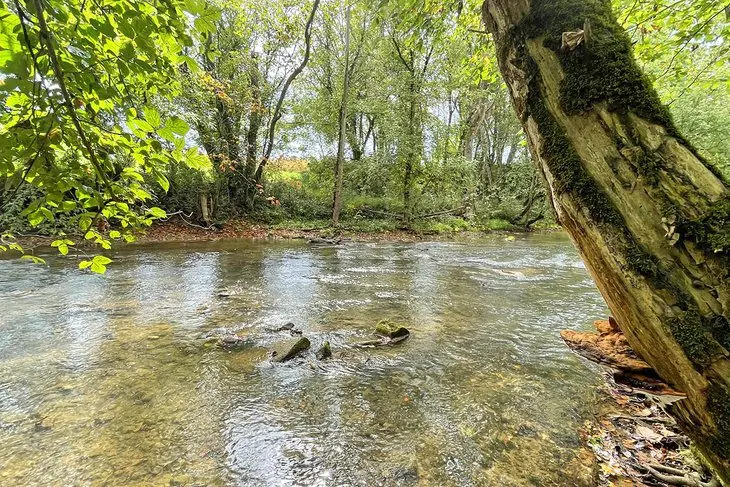
Davy Crockett, one of America’s most famous folk heroes, was born near Limestone, Tennessee, in 1786. A pioneer, politician, and soldier, Crockett died at the Alamo, fighting for freedom for Texas.
The 105-acre state park that honors his birthplace is located about 21 miles southwest of Johnson City. You’ll encounter folks in costume at the historic park and weathered buildings, including a farmstead that dates to the 18th century.
The park isn’t just about Davy Crockett. You can camp here, explore the natural world, and seek glimpses of birds and wildlife. Anglers catch smallmouth bass and catfish from the Nolichucky River, which runs through the park.
Address: 1245 Davy Crockett Park Road, Limestone, Tennessee










